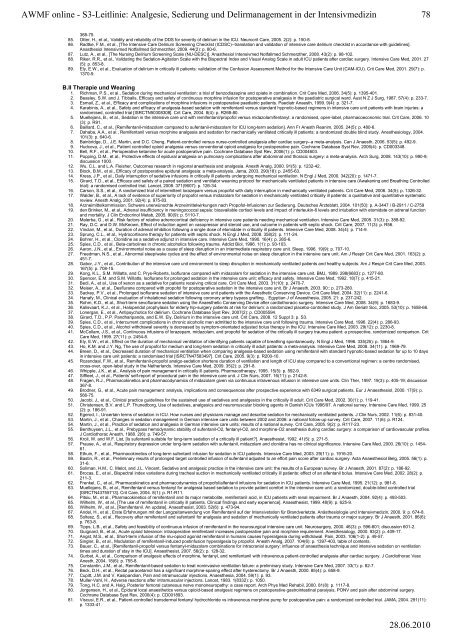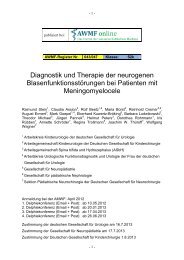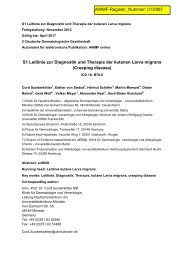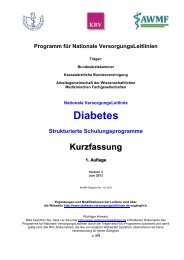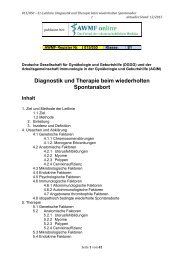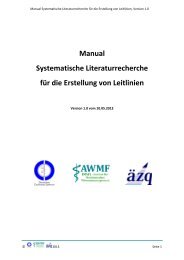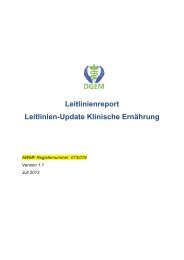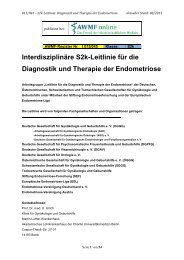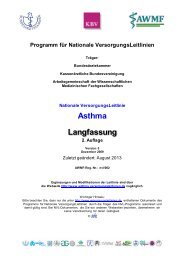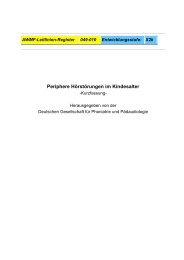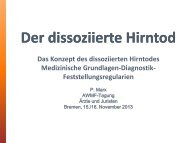Analgesie, Sedierung und Delirmanagement in der Intensivmedizin ...
Analgesie, Sedierung und Delirmanagement in der Intensivmedizin ...
Analgesie, Sedierung und Delirmanagement in der Intensivmedizin ...
Sie wollen auch ein ePaper? Erhöhen Sie die Reichweite Ihrer Titel.
YUMPU macht aus Druck-PDFs automatisch weboptimierte ePaper, die Google liebt.
AWMF onl<strong>in</strong>e - S3-Leitl<strong>in</strong>ie: <strong>Analgesie</strong>, <strong>Sedierung</strong> <strong>und</strong> <strong>Delirmanagement</strong> <strong>in</strong> <strong>der</strong> Intensivmediz<strong>in</strong><br />
368-75.<br />
85. Otter, H., et al., Validity and reliability of the DDS for severity of delirium <strong>in</strong> the ICU. Neurocrit Care, 2005. 2(2): p. 150-8.<br />
86. Radtke, F.M., et al., [The Intensive Care Delirium Screen<strong>in</strong>g Checklist (ICDSC)--translation and validation of <strong>in</strong>tensive care delirium checklist <strong>in</strong> accordance with guidel<strong>in</strong>es].<br />
Anasthesiol Intensivmed Notfallmed Schmerzther, 2009. 44(2): p. 80-6.<br />
87. Lutz, A., et al., [The Nurs<strong>in</strong>g Delirium Screen<strong>in</strong>g Scale (NU-DESC)]. Anasthesiol Intensivmed Notfallmed Schmerzther, 2008. 43(2): p. 98-102.<br />
88. Riker, R.R., et al., Validat<strong>in</strong>g the Sedation-Agitation Scale with the Bispectral Index and Visual Analog Scale <strong>in</strong> adult ICU patients after cardiac surgery. Intensive Care Med, 2001. 27<br />
(5): p. 853-8.<br />
89. Ely, E.W., et al., Evaluation of delirium <strong>in</strong> critically ill patients: validation of the Confusion Assessment Method for the Intensive Care Unit (CAM-ICU). Crit Care Med, 2001. 29(7): p.<br />
1370-9.<br />
B.II Therapie <strong>und</strong> Wean<strong>in</strong>g<br />
1. Richman, P.S., et al., Sedation dur<strong>in</strong>g mechanical ventilation: a trial of benzodiazep<strong>in</strong>e and opiate <strong>in</strong> comb<strong>in</strong>ation. Crit Care Med, 2006. 34(5): p. 1395-401.<br />
2. Beasley, S.W. and J. Tibballs, Efficacy and safety of cont<strong>in</strong>uous morph<strong>in</strong>e <strong>in</strong>fusion for postoperative analgesia <strong>in</strong> the paediatric surgical ward. Aust N Z J Surg, 1987. 57(4): p. 233-7.<br />
3. Esmail, Z., et al., Efficacy and complications of morph<strong>in</strong>e <strong>in</strong>fusions <strong>in</strong> postoperative paediatric patients. Paediatr Anaesth, 1999. 9(4): p. 321-7.<br />
4. Karab<strong>in</strong>is, A., et al., Safety and efficacy of analgesia-based sedation with remifentanil versus standard hypnotic-based regimens <strong>in</strong> <strong>in</strong>tensive care unit patients with bra<strong>in</strong> <strong>in</strong>juries: a<br />
randomised, controlled trial [ISRCTN50308308]. Crit Care, 2004. 8(4): p. R268-80.<br />
5. Muellejans, B., et al., Sedation <strong>in</strong> the <strong>in</strong>tensive care unit with remifentanil/propofol versus midazolam/fentanyl: a randomised, open-label, pharmacoeconomic trial. Crit Care, 2006. 10<br />
(3): p. R91.<br />
6. Baillard, C., et al., [Remifentanil-midazolam compared to sufentanil-midazolam for ICU long-term sedation]. Ann Fr Anesth Reanim, 2005. 24(5): p. 480-6.<br />
7. Dahaba, A.A., et al., Remifentanil versus morph<strong>in</strong>e analgesia and sedation for mechanically ventilated critically ill patients: a randomized double bl<strong>in</strong>d study. Anesthesiology, 2004.<br />
101(3): p. 640-6.<br />
8. Ba<strong>in</strong>bridge, D., J.E. Mart<strong>in</strong>, and D.C. Cheng, Patient-controlled versus nurse-controlled analgesia after cardiac surgery--a meta-analysis. Can J Anaesth, 2006. 53(5): p. 492-9.<br />
9. Hudcova, J., et al., Patient controlled opioid analgesia versus conventional opioid analgesia for postoperative pa<strong>in</strong>. Cochrane Database Syst Rev, 2006(4): p. CD003348.<br />
10. Bell, R.F., et al., Perioperative ketam<strong>in</strong>e for acute postoperative pa<strong>in</strong>. Cochrane Database Syst Rev, 2006(1): p. CD004603.<br />
11. Popp<strong>in</strong>g, D.M., et al., Protective effects of epidural analgesia on pulmonary complications after abdom<strong>in</strong>al and thoracic surgery: a meta-analysis. Arch Surg, 2008. 143(10): p. 990-9;<br />
discussion 1000.<br />
12. Wu, C.L. and L.A. Fleisher, Outcomes research <strong>in</strong> regional anesthesia and analgesia. Anesth Analg, 2000. 91(5): p. 1232-42.<br />
13. Block, B.M., et al., Efficacy of postoperative epidural analgesia: a meta-analysis. Jama, 2003. 290(18): p. 2455-63.<br />
14. Kress, J.P., et al., Daily <strong>in</strong>terruption of sedative <strong>in</strong>fusions <strong>in</strong> critically ill patients <strong>und</strong>ergo<strong>in</strong>g mechanical ventilation. N Engl J Med, 2000. 342(20): p. 1471-7.<br />
15. Girard, T.D., et al., Efficacy and safety of a paired sedation and ventilator wean<strong>in</strong>g protocol for mechanically ventilated patients <strong>in</strong> <strong>in</strong>tensive care (Awaken<strong>in</strong>g and Breath<strong>in</strong>g Controlled<br />
trial): a randomised controlled trial. Lancet, 2008. 371(9607): p. 126-34.<br />
16. Carson, S.S., et al., A randomized trial of <strong>in</strong>termittent lorazepam versus propofol with daily <strong>in</strong>terruption <strong>in</strong> mechanically ventilated patients. Crit Care Med, 2006. 34(5): p. 1326-32.<br />
17. Wal<strong>der</strong>, B., et al., A lack of evidence of superiority of propofol versus midazolam for sedation <strong>in</strong> mechanically ventilated critically ill patients: a qualitative and quantitative systematic<br />
review. Anesth Analg, 2001. 92(4): p. 975-83.<br />
18. Arzneimittelkommission, Schwere unerwünschte Arzneimittelwirkungen nach Propofol-Infusionen zur <strong>Sedierung</strong>. Deutsches Ärzteblatt, 2004. 101(50): p. A-3447 / B-2911 / C-2759<br />
19. den Br<strong>in</strong>ker, M., et al., Adrenal <strong>in</strong>sufficiency <strong>in</strong> men<strong>in</strong>gococcal sepsis: bioavailable cortisol levels and impact of <strong>in</strong>terleuk<strong>in</strong>-6 levels and <strong>in</strong>tubation with etomidate on adrenal function<br />
and mortality. J Cl<strong>in</strong> Endocr<strong>in</strong>ol Metab, 2005. 90(9): p. 5110-7.<br />
20. Malerba, G., et al., Risk factors of relative adrenocortical deficiency <strong>in</strong> <strong>in</strong>tensive care patients need<strong>in</strong>g mechanical ventilation. Intensive Care Med, 2005. 31(3): p. 388-92.<br />
21. Ray, D.C. and D.W. McKeown, Effect of <strong>in</strong>duction agent on vasopressor and steroid use, and outcome <strong>in</strong> patients with septic shock. Crit Care, 2007. 11(3): p. R56.<br />
22. V<strong>in</strong>clair, M., et al., Duration of adrenal <strong>in</strong>hibition follow<strong>in</strong>g a s<strong>in</strong>gle dose of etomidate <strong>in</strong> critically ill patients. Intensive Care Med, 2008. 34(4): p. 714-9.<br />
23. Sprung, C.L., et al., Hydrocortisone therapy for patients with septic shock. N Engl J Med, 2008. 358(2): p. 111-24.<br />
24. Bohrer, H., et al., Clonid<strong>in</strong>e as a sedative adjunct <strong>in</strong> <strong>in</strong>tensive care. Intensive Care Med, 1990. 16(4): p. 265-6.<br />
25. Spies, C.D., et al., Beta-carbol<strong>in</strong>es <strong>in</strong> chronic alcoholics follow<strong>in</strong>g trauma. Addict Biol, 1996. 1(1): p. 93-103.<br />
26. Aaron, J.N., et al., Environmental noise as a cause of sleep disruption <strong>in</strong> an <strong>in</strong>termediate respiratory care unit. Sleep, 1996. 19(9): p. 707-10.<br />
27. Freedman, N.S., et al., Abnormal sleep/wake cycles and the effect of environmental noise on sleep disruption <strong>in</strong> the <strong>in</strong>tensive care unit. Am J Respir Crit Care Med, 2001. 163(2): p.<br />
451-7.<br />
28. Gabor, J.Y., et al., Contribution of the <strong>in</strong>tensive care unit environment to sleep disruption <strong>in</strong> mechanically ventilated patients and healthy subjects. Am J Respir Crit Care Med, 2003.<br />
167(5): p. 708-15.<br />
29. Kong, K.L., S.M. Willatts, and C. Prys-Roberts, Isoflurane compared with midazolam for sedation <strong>in</strong> the <strong>in</strong>tensive care unit. BMJ, 1989. 298(6683): p. 1277-80.<br />
30. Spencer, E.M. and S.M. Willatts, Isoflurane for prolonged sedation <strong>in</strong> the <strong>in</strong>tensive care unit; efficacy and safety. Intensive Care Med, 1992. 18(7): p. 415-21.<br />
31. Bedi, A., et al., Use of xenon as a sedative for patients receiv<strong>in</strong>g critical care. Crit Care Med, 2003. 31(10): p. 2470-7.<br />
32. Meiser, A., et al., Desflurane compared with propofol for postoperative sedation <strong>in</strong> the <strong>in</strong>tensive care unit. Br J Anaesth, 2003. 90:: p. 273-280.<br />
33. Sackey, P.V., et al., Prolonged isoflurane sedation of <strong>in</strong>tensive care unit patients with the Anesthetic Conserv<strong>in</strong>g Device. Crit Care Med, 2004. 32(11): p. 2241-6.<br />
34. Hanafy, M., Cl<strong>in</strong>ical evaluation of <strong>in</strong>halational sedation follow<strong>in</strong>g coronary artery bypass graft<strong>in</strong>g. . Egyptian J of Anaesthesia, 2005. 21: p. 237-242.<br />
35. Rohm, K.D., et al., Short-term sevoflurane sedation us<strong>in</strong>g the Anaesthetic Conserv<strong>in</strong>g Device after cardiothoracic surgery. Intensive Care Med, 2008. 34(9): p. 1683-9.<br />
36. Kalisvaart, K.J., et al., Haloperidol prophylaxis for el<strong>der</strong>ly hip-surgery patients at risk for delirium: a randomized placebo-controlled study. J Am Geriatr Soc, 2005. 53(10): p. 1658-66.<br />
37. Lonergan, E., et al., Antipsychotics for delirium. Cochrane Database Syst Rev, 2007(2): p. CD005594.<br />
38. Girard, T.D., P.P. Pandharipande, and E.W. Ely, Delirium <strong>in</strong> the <strong>in</strong>tensive care unit. Crit Care, 2008. 12 Suppl 3: p. S3.<br />
39. Spies, C.D., et al., Intercurrent complications <strong>in</strong> chronic alcoholic men admitted to the <strong>in</strong>tensive care unit follow<strong>in</strong>g trauma. Intensive Care Med, 1996. 22(4): p. 286-93.<br />
40. Spies, C.D., et al., Alcohol withdrawal severity is decreased by symptom-orientated adjusted bolus therapy <strong>in</strong> the ICU. Intensive Care Med, 2003. 29(12): p. 2230-8.<br />
41. McCollam, J.S., et al., Cont<strong>in</strong>uous <strong>in</strong>fusions of lorazepam, midazolam, and propofol for sedation of the critically ill surgery trauma patient: a prospective, randomized comparison. Crit<br />
Care Med, 1999. 27(11): p. 2454-8.<br />
42. Ely, E.W., et al., Effect on the duration of mechanical ventilation of identify<strong>in</strong>g patients capable of breath<strong>in</strong>g spontaneously. N Engl J Med, 1996. 335(25): p. 1864-9.<br />
43. Ho, K.M. and J.Y. Ng, The use of propofol for medium and long-term sedation <strong>in</strong> critically ill adult patients: a meta-analysis. Intensive Care Med, 2008. 34(11): p. 1969-79.<br />
44. Breen, D., et al., Decreased duration of mechanical ventilation when compar<strong>in</strong>g analgesia-based sedation us<strong>in</strong>g remifentanil with standard hypnotic-based sedation for up to 10 days<br />
<strong>in</strong> <strong>in</strong>tensive care unit patients: a randomised trial [ISRCTN47583497]. Crit Care, 2005. 9(3): p. R200-10.<br />
45. Rozendaal, F.W., et al., Remifentanil-propofol analgo-sedation shortens duration of ventilation and length of ICU stay compared to a conventional regimen: a centre randomised,<br />
cross-over, open-label study <strong>in</strong> the Netherlands. Intensive Care Med, 2009. 35(2): p. 291-8.<br />
46. Whipple, J.K., et al., Analysis of pa<strong>in</strong> management <strong>in</strong> critically ill patients. Pharmacotherapy, 1995. 15(5): p. 592-9.<br />
47. Siffleet, J., et al., Patients' self-report of procedural pa<strong>in</strong> <strong>in</strong> the <strong>in</strong>tensive care unit. J Cl<strong>in</strong> Nurs, 2007. 16(11): p. 2142-8.<br />
48. Fragen, R.J., Pharmacok<strong>in</strong>etics and pharmacodynamics of midazolam given via cont<strong>in</strong>uous <strong>in</strong>travenous <strong>in</strong>fusion <strong>in</strong> <strong>in</strong>tensive care units. Cl<strong>in</strong> Ther, 1997. 19(3): p. 405-19; discussion<br />
367-8.<br />
49. Brodner, G., et al., Acute pa<strong>in</strong> management: analysis, implications and consequences after prospective experience with 6349 surgical patients. Eur J Anaesthesiol, 2000. 17(9): p.<br />
566-75.<br />
50. Jacobi, J., et al., Cl<strong>in</strong>ical practice guidel<strong>in</strong>es for the susta<strong>in</strong>ed use of sedatives and analgesics <strong>in</strong> the critically ill adult. Crit Care Med, 2002. 30(1): p. 119-41.<br />
51. Christensen, B.V. and L.P. Thunedborg, Use of sedatives, analgesics and neuromuscular block<strong>in</strong>g agents <strong>in</strong> Danish ICUs 1996/97. A national survey. Intensive Care Med, 1999. 25<br />
(2): p. 186-91.<br />
52. Egerod, I., Uncerta<strong>in</strong> terms of sedation <strong>in</strong> ICU. How nurses and physicians manage and describe sedation for mechanically ventilated patients. J Cl<strong>in</strong> Nurs, 2002. 11(6): p. 831-40.<br />
53. Mart<strong>in</strong>, J., et al., Changes <strong>in</strong> sedation management <strong>in</strong> German <strong>in</strong>tensive care units between 2002 and 2006: a national follow-up survey. Crit Care, 2007. 11(6): p. R124.<br />
54. Mart<strong>in</strong>, J., et al., Practice of sedation and analgesia <strong>in</strong> German <strong>in</strong>tensive care units: results of a national survey. Crit Care, 2005. 9(2): p. R117-23.<br />
55. Benthuysen, J.L., et al., Prebypass hemodynamic stability of sufentanil-O2, fentanyl-O2, and morph<strong>in</strong>e-O2 anesthesia dur<strong>in</strong>g cardiac surgery: a comparison of cardiovascular profiles.<br />
J Cardiothorac Anesth, 1988. 2(6): p. 749-57.<br />
56. Kroll, W. and W.F. List, [Is sufentanil suitable for long-term sedation of a critically ill patient?]. Anaesthesist, 1992. 41(5): p. 271-5.<br />
57. Prause, A., et al., Respiratory depression <strong>und</strong>er long-term sedation with sufentanil, midazolam and clonid<strong>in</strong>e has no cl<strong>in</strong>ical significance. Intensive Care Med, 2000. 26(10): p. 1454-<br />
61.<br />
58. Ethu<strong>in</strong>, F., et al., Pharmacok<strong>in</strong>etics of long-term sufentanil <strong>in</strong>fusion for sedation <strong>in</strong> ICU patients. Intensive Care Med, 2003. 29(11): p. 1916-20.<br />
59. Bast<strong>in</strong>, R., et al., Prelim<strong>in</strong>ary results of prolonged target controlled <strong>in</strong>fusion of sufentanil adjusted to an effort pa<strong>in</strong> score after cardiac surgery. Acta Anaesthesiol Belg, 2005. 56(1): p.<br />
31-6.<br />
60. Soliman, H.M., C. Melot, and J.L. V<strong>in</strong>cent, Sedative and analgesic practice <strong>in</strong> the <strong>in</strong>tensive care unit: the results of a European survey. Br J Anaesth, 2001. 87(2): p. 186-92.<br />
61. Brocas, E., et al., Bispectral <strong>in</strong>dex variations dur<strong>in</strong>g tracheal suction <strong>in</strong> mechanically ventilated critically ill patients: effect of an alfentanil bolus. Intensive Care Med, 2002. 28(2): p.<br />
211-3.<br />
62. Frenkel, C., et al., Pharmacok<strong>in</strong>etics and pharmacodynamics of propofol/alfentanil <strong>in</strong>fusions for sedation <strong>in</strong> ICU patients. Intensive Care Med, 1995. 21(12): p. 981-8.<br />
63. Muellejans, B., et al., Remifentanil versus fentanyl for analgesia based sedation to provide patient comfort <strong>in</strong> the <strong>in</strong>tensive care unit: a randomized, double-bl<strong>in</strong>d controlled trial<br />
[ISRCTN43755713]. Crit Care, 2004. 8(1): p. R1-R11.<br />
64. Pitsiu, M., et al., Pharmacok<strong>in</strong>etics of remifentanil and its major metabolite, remifentanil acid, <strong>in</strong> ICU patients with renal impairment. Br J Anaesth, 2004. 92(4): p. 493-503.<br />
65. Wilhelm, W., et al., [The use of remifentanil <strong>in</strong> critically ill patients. Cl<strong>in</strong>ical f<strong>in</strong>d<strong>in</strong>gs and early experience]. Anaesthesist, 1999. 48(9): p. 625-9.<br />
66. Wilhelm, W., et al., [Remifentanil. An update]. Anaesthesist, 2003. 52(6): p. 473-94.<br />
67. Andel, H., et al., Erste Erfahrungen mit <strong>der</strong> Langzeitanwendung von Remifentanil auf <strong>der</strong> Intensivstation für Brandverletzte. Anästhesiologie <strong>und</strong> Intensivmediz<strong>in</strong>, 2000. 9: p. 674-8.<br />
68. Soltesz, S., et al., Recovery after remifentanil and sufentanil for analgesia and sedation of mechanically ventilated patients after trauma or major surgery. Br J Anaesth, 2001. 86(6):<br />
p. 763-8.<br />
69. Tipps, L.B., et al., Safety and feasibility of cont<strong>in</strong>uous <strong>in</strong>fusion of remifentanil <strong>in</strong> the neurosurgical <strong>in</strong>tensive care unit. Neurosurgery, 2000. 46(3): p. 596-601; discussion 601-2.<br />
70. Guignard, B., et al., Acute opioid tolerance: <strong>in</strong>traoperative remifentanil <strong>in</strong>creases postoperative pa<strong>in</strong> and morph<strong>in</strong>e requirement. Anesthesiology, 2000. 93(2): p. 409-17.<br />
71. Angst, M.S., et al., Short-term <strong>in</strong>fusion of the mu-opioid agonist remifentanil <strong>in</strong> humans causes hyperalgesia dur<strong>in</strong>g withdrawal. Pa<strong>in</strong>, 2003. 106(1-2): p. 49-57.<br />
72. S<strong>in</strong>gler, B., et al., Modulation of remifentanil-<strong>in</strong>duced post<strong>in</strong>fusion hyperalgesia by propofol. Anesth Analg, 2007. 104(6): p. 1397-403, table of contents.<br />
73. Bauer, C., et al., [Remifentanil-propofol versus fentanyl-midazolam comb<strong>in</strong>ations for <strong>in</strong>tracranial surgery: <strong>in</strong>fluence of anaesthesia technique and <strong>in</strong>tensive sedation on ventilation<br />
times and duration of stay <strong>in</strong> the ICU]. Anaesthesist, 2007. 56(2): p. 128-32.<br />
74. Gurbet, A., et al., Comparison of analgesic effects of morph<strong>in</strong>e, fentanyl, and remifentanil with <strong>in</strong>travenous patient-controlled analgesia after cardiac surgery. J Cardiothorac Vasc<br />
Anesth, 2004. 18(6): p. 755-8.<br />
75. Constant<strong>in</strong>, J.M., et al., Remifentanil-based sedation to treat non<strong>in</strong>vasive ventilation failure: a prelim<strong>in</strong>ary study. Intensive Care Med, 2007. 33(1): p. 82-7.<br />
76. Beck, D.H., et al., Rectal paracetamol has a significant morph<strong>in</strong>e-spar<strong>in</strong>g effect after hysterectomy. Br J Anaesth, 2000. 85(4): p. 658-9.<br />
77. Cupitt, J.M. and V. Kasipandian, Pa<strong>in</strong> and <strong>in</strong>tramuscular <strong>in</strong>jections. Anaesthesia, 2004. 59(1): p. 93.<br />
78. Muller-Vahl, H., Adverse reactions after <strong>in</strong>tramuscular <strong>in</strong>jections. Lancet, 1983. 1(8332): p. 1050.<br />
79. Tong, H.C. and A. Haig, Posterior femoral cutaneous nerve mononeuropathy: a case report. Arch Phys Med Rehabil, 2000. 81(8): p. 1117-8.<br />
80. Jorgensen, H., et al., Epidural local anaesthetics versus opioid-based analgesic regimens on postoperative gastro<strong>in</strong>test<strong>in</strong>al paralysis, PONV and pa<strong>in</strong> after abdom<strong>in</strong>al surgery.<br />
Cochrane Database Syst Rev, 2000(4): p. CD001893.<br />
81. Viscusi, E.R., et al., Patient-controlled trans<strong>der</strong>mal fentanyl hydrochloride vs <strong>in</strong>travenous morph<strong>in</strong>e pump for postoperative pa<strong>in</strong>: a randomized controlled trial. JAMA, 2004. 291(11):<br />
p. 1333-41.<br />
78<br />
28.06.2010


